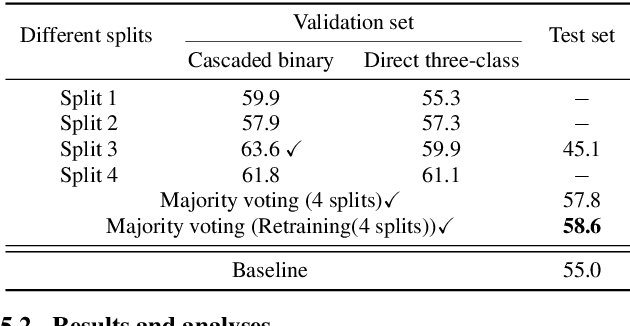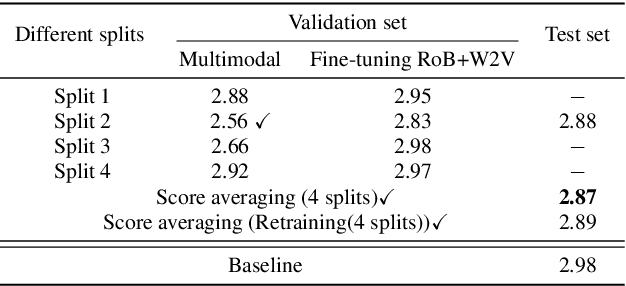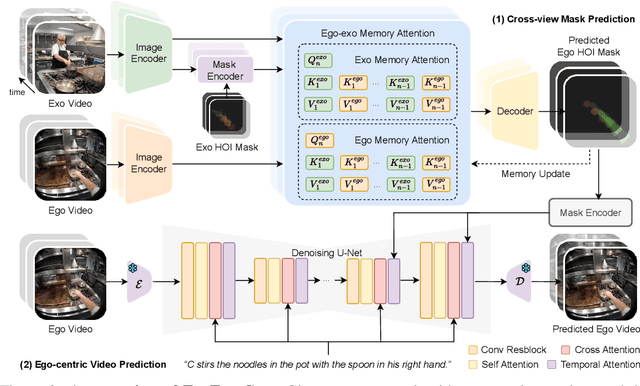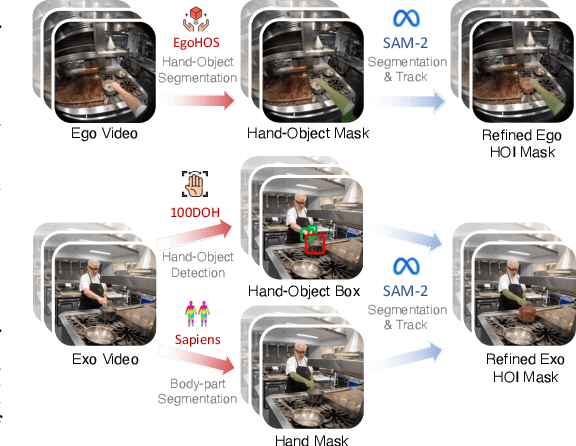Rui Feng
Georgia Institute of Technology
EGGCodec: A Robust Neural Encodec Framework for EGG Reconstruction and F0 Extraction
Aug 12, 2025Abstract:This letter introduces EGGCodec, a robust neural Encodec framework engineered for electroglottography (EGG) signal reconstruction and F0 extraction. We propose a multi-scale frequency-domain loss function to capture the nuanced relationship between original and reconstructed EGG signals, complemented by a time-domain correlation loss to improve generalization and accuracy. Unlike conventional Encodec models that extract F0 directly from features, EGGCodec leverages reconstructed EGG signals, which more closely correspond to F0. By removing the conventional GAN discriminator, we streamline EGGCodec's training process without compromising efficiency, incurring only negligible performance degradation. Trained on a widely used EGG-inclusive dataset, extensive evaluations demonstrate that EGGCodec outperforms state-of-the-art F0 extraction schemes, reducing mean absolute error (MAE) from 14.14 Hz to 13.69 Hz, and improving voicing decision error (VDE) by 38.2\%. Moreover, extensive ablation experiments validate the contribution of each component of EGGCodec.
Exploring Gender Bias in Alzheimer's Disease Detection: Insights from Mandarin and Greek Speech Perception
Jul 16, 2025Abstract:Gender bias has been widely observed in speech perception tasks, influenced by the fundamental voicing differences between genders. This study reveals a gender bias in the perception of Alzheimer's Disease (AD) speech. In a perception experiment involving 16 Chinese listeners evaluating both Chinese and Greek speech, we identified that male speech was more frequently identified as AD, with this bias being particularly pronounced in Chinese speech. Acoustic analysis showed that shimmer values in male speech were significantly associated with AD perception, while speech portion exhibited a significant negative correlation with AD identification. Although language did not have a significant impact on AD perception, our findings underscore the critical role of gender bias in AD speech perception. This work highlights the necessity of addressing gender bias when developing AD detection models and calls for further research to validate model performance across different linguistic contexts.
Dual Semantic-Aware Network for Noise Suppressed Ultrasound Video Segmentation
Jul 10, 2025Abstract:Ultrasound imaging is a prevalent diagnostic tool known for its simplicity and non-invasiveness. However, its inherent characteristics often introduce substantial noise, posing considerable challenges for automated lesion or organ segmentation in ultrasound video sequences. To address these limitations, we propose the Dual Semantic-Aware Network (DSANet), a novel framework designed to enhance noise robustness in ultrasound video segmentation by fostering mutual semantic awareness between local and global features. Specifically, we introduce an Adjacent-Frame Semantic-Aware (AFSA) module, which constructs a channel-wise similarity matrix to guide feature fusion across adjacent frames, effectively mitigating the impact of random noise without relying on pixel-level relationships. Additionally, we propose a Local-and-Global Semantic-Aware (LGSA) module that reorganizes and fuses temporal unconditional local features, which capture spatial details independently at each frame, with conditional global features that incorporate temporal context from adjacent frames. This integration facilitates multi-level semantic representation, significantly improving the model's resilience to noise interference. Extensive evaluations on four benchmark datasets demonstrate that DSANet substantially outperforms state-of-the-art methods in segmentation accuracy. Moreover, since our model avoids pixel-level feature dependencies, it achieves significantly higher inference FPS than video-based methods, and even surpasses some image-based models. Code can be found in \href{https://github.com/ZhouL2001/DSANet}{DSANet}
Advancing Lung Disease Diagnosis in 3D CT Scans
Jul 01, 2025Abstract:To enable more accurate diagnosis of lung disease in chest CT scans, we propose a straightforward yet effective model. Firstly, we analyze the characteristics of 3D CT scans and remove non-lung regions, which helps the model focus on lesion-related areas and reduces computational cost. We adopt ResNeSt50 as a strong feature extractor, and use a weighted cross-entropy loss to mitigate class imbalance, especially for the underrepresented squamous cell carcinoma category. Our model achieves a Macro F1 Score of 0.80 on the validation set of the Fair Disease Diagnosis Challenge, demonstrating its strong performance in distinguishing between different lung conditions.
Decoding Speaker-Normalized Pitch from EEG for Mandarin Perception
May 26, 2025Abstract:The same speech content produced by different speakers exhibits significant differences in pitch contour, yet listeners' semantic perception remains unaffected. This phenomenon may stem from the brain's perception of pitch contours being independent of individual speakers' pitch ranges. In this work, we recorded electroencephalogram (EEG) while participants listened to Mandarin monosyllables with varying tones, phonemes, and speakers. The CE-ViViT model is proposed to decode raw or speaker-normalized pitch contours directly from EEG. Experimental results demonstrate that the proposed model can decode pitch contours with modest errors, achieving performance comparable to state-of-the-art EEG regression methods. Moreover, speaker-normalized pitch contours were decoded more accurately, supporting the neural encoding of relative pitch.
Beyond Manual Transcripts: The Potential of Automated Speech Recognition Errors in Improving Alzheimer's Disease Detection
May 26, 2025Abstract:Recent breakthroughs in Automatic Speech Recognition (ASR) have enabled fully automated Alzheimer's Disease (AD) detection using ASR transcripts. Nonetheless, the impact of ASR errors on AD detection remains poorly understood. This paper fills the gap. We conduct a comprehensive study on AD detection using transcripts from various ASR models and their synthesized speech on the ADReSS dataset. Experimental results reveal that certain ASR transcripts (ASR-synthesized speech) outperform manual transcripts (manual-synthesized speech) in detection accuracy, suggesting that ASR errors may provide valuable cues for improving AD detection. Additionally, we propose a cross-attention-based interpretability model that not only identifies these cues but also achieves superior or comparable performance to the baseline. Furthermore, we utilize this model to unveil AD-related patterns within pre-trained embeddings. Our study offers novel insights into the potential of ASR models for AD detection.
Leveraging Cascaded Binary Classification and Multimodal Fusion for Dementia Detection through Spontaneous Speech
May 26, 2025


Abstract:This paper presents our submission to the PROCESS Challenge 2025, focusing on spontaneous speech analysis for early dementia detection. For the three-class classification task (Healthy Control, Mild Cognitive Impairment, and Dementia), we propose a cascaded binary classification framework that fine-tunes pre-trained language models and incorporates pause encoding to better capture disfluencies. This design streamlines multi-class classification and addresses class imbalance by restructuring the decision process. For the Mini-Mental State Examination score regression task, we develop an enhanced multimodal fusion system that combines diverse acoustic and linguistic features. Separate regression models are trained on individual feature sets, with ensemble learning applied through score averaging. Experimental results on the test set outperform the baselines provided by the organizers in both tasks, demonstrating the robustness and effectiveness of our approach.
AOR: Anatomical Ontology-Guided Reasoning for Medical Large Multimodal Model in Chest X-Ray Interpretation
May 05, 2025Abstract:Chest X-rays (CXRs) are the most frequently performed imaging examinations in clinical settings. Recent advancements in Large Multimodal Models (LMMs) have enabled automated CXR interpretation, enhancing diagnostic accuracy and efficiency. However, despite their strong visual understanding, current Medical LMMs (MLMMs) still face two major challenges: (1) Insufficient region-level understanding and interaction, and (2) Limited accuracy and interpretability due to single-step reasoning. In this paper, we empower MLMMs with anatomy-centric reasoning capabilities to enhance their interactivity and explainability. Specifically, we first propose an Anatomical Ontology-Guided Reasoning (AOR) framework, which centers on cross-modal region-level information to facilitate multi-step reasoning. Next, under the guidance of expert physicians, we develop AOR-Instruction, a large instruction dataset for MLMMs training. Our experiments demonstrate AOR's superior performance in both VQA and report generation tasks.
EgoExo-Gen: Ego-centric Video Prediction by Watching Exo-centric Videos
Apr 16, 2025



Abstract:Generating videos in the first-person perspective has broad application prospects in the field of augmented reality and embodied intelligence. In this work, we explore the cross-view video prediction task, where given an exo-centric video, the first frame of the corresponding ego-centric video, and textual instructions, the goal is to generate futur frames of the ego-centric video. Inspired by the notion that hand-object interactions (HOI) in ego-centric videos represent the primary intentions and actions of the current actor, we present EgoExo-Gen that explicitly models the hand-object dynamics for cross-view video prediction. EgoExo-Gen consists of two stages. First, we design a cross-view HOI mask prediction model that anticipates the HOI masks in future ego-frames by modeling the spatio-temporal ego-exo correspondence. Next, we employ a video diffusion model to predict future ego-frames using the first ego-frame and textual instructions, while incorporating the HOI masks as structural guidance to enhance prediction quality. To facilitate training, we develop an automated pipeline to generate pseudo HOI masks for both ego- and exo-videos by exploiting vision foundation models. Extensive experiments demonstrate that our proposed EgoExo-Gen achieves better prediction performance compared to previous video prediction models on the Ego-Exo4D and H2O benchmark datasets, with the HOI masks significantly improving the generation of hands and interactive objects in the ego-centric videos.
Repurposing the scientific literature with vision-language models
Feb 26, 2025Abstract:Research in AI for Science often focuses on using AI technologies to augment components of the scientific process, or in some cases, the entire scientific method; how about AI for scientific publications? Peer-reviewed journals are foundational repositories of specialized knowledge, written in discipline-specific language that differs from general Internet content used to train most large language models (LLMs) and vision-language models (VLMs). We hypothesized that by combining a family of scientific journals with generative AI models, we could invent novel tools for scientific communication, education, and clinical care. We converted 23,000 articles from Neurosurgery Publications into a multimodal database - NeuroPubs - of 134 million words and 78,000 image-caption pairs to develop six datasets for building AI models. We showed that the content of NeuroPubs uniquely represents neurosurgery-specific clinical contexts compared with broader datasets and PubMed. For publishing, we employed generalist VLMs to automatically generate graphical abstracts from articles. Editorial board members rated 70% of these as ready for publication without further edits. For education, we generated 89,587 test questions in the style of the ABNS written board exam, which trainee and faculty neurosurgeons found indistinguishable from genuine examples 54% of the time. We used these questions alongside a curriculum learning process to track knowledge acquisition while training our 34 billion-parameter VLM (CNS-Obsidian). In a blinded, randomized controlled trial, we demonstrated the non-inferiority of CNS-Obsidian to GPT-4o (p = 0.1154) as a diagnostic copilot for a neurosurgical service. Our findings lay a novel foundation for AI with Science and establish a framework to elevate scientific communication using state-of-the-art generative artificial intelligence while maintaining rigorous quality standards.
 Add to Chrome
Add to Chrome Add to Firefox
Add to Firefox Add to Edge
Add to Edge